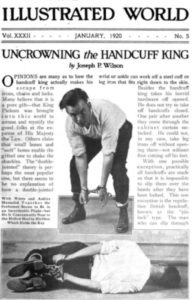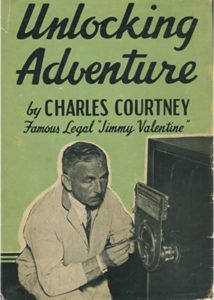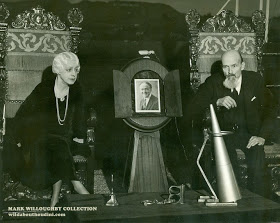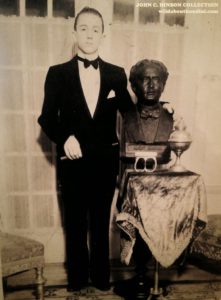Added a couple of new items to my collection while researching the Mirror Cuff:
- “Uncrowning the Handcuff King” by Joseph P. Wilson, January 1920 issue of Illustrated World Magazine
- “Unlocking Adventure” by Charles Courtney (1942)
Both are discussed in Chapter Eight, “The Mirror Handcuff Mystery”, of Patrick Culliton’s book, “the Key” and offer key insights into the Mirror Cuff Challenge.
- Joseph P. Wilson’s theory on how Houdini Escaped the Mirror Cuff
- Locksmith, Charles Courtney had come upon a Mirror Cuff inside Houdini’s private safe after the magician’s death and offered to open them, but Bessie inferred that only Houdini was allowed to unlock them
Culliton asks the question, “Could it be that Bessie Houdini was preventing Courtney from discovering that beyond that single Brahma lock lay the “false works” that Wilson described in his article?”
Joseph P. Wilson’s theory on how Houdini escaped the Mirror Cuff, is also discussed in the chapter, “How He Did It (Theory Two)” of Joe Posnanski’s book, “The Life and Afterlife of Harry Houdini”. Posnanski’s says “Wilson did not get it right”, since his claim was built around the premise that the Mirror Cuffs were gaffed and the one’s in David Copperfield’s collection are not. Well the Tatler Cuff may have been gaffed.
Here is the related snippet from Courtney:
Mrs. Houdini…asking me to unlock her husband’s safe, the one he used in his act. In the safe, he had told her, was something to treasure but no one had been able to open the lock. On my next trip [1935] to the West, I paid her a visit in Hollywood. This gentle, tiny woman was living in a small home [2435 Laurel Canyon Blvd] surrounded by her keepsakes and sharing her home with a half-dozen elderly actresses who had no work. Her two chief concerns were a small two- or three pound monkey [named Satan], a pet that she carried everywhere perched on her shoulder, and portrait of Houdini under which an oil lamp burned perpetually. The lock on the chest was a trick one, I knew, so I asked Mrs. Houdini very carefully just how her husband opened it.
“Houdini never touched it,” she told me. “He just passed his hands over it and it opened.” I went around the corner to the hardware store, returned in a few minutes and passed my hands over the lock. It opened immediately. The elderly actresses crowded around and asked me how I learned the trick, but my only magic was a small magnet that clicked with another in the shackle of the lock. On the floor of the chest lay the beautiful silver [?] handcuffs that the city of London had once presented to the magician. They were fastened with one of the finest Bramah locks that I have seen. It would have been interesting to open them, but Mrs. Houdini shook her head.
“I must never let anyone touch the lock. You may have the safe for your collection; Houdini would have wished it. But these handcuffs–he promised that if he can pierce the veil of death, he will unlock them. Then I shall know that he has returned to me.”
The Billboard August 3, 1935 mentions the following:
THE LATE HOUDINI’S trick of opening a closed safe by passing his hands over it was exposed last week by Charles Courtney, president of the Master Locksmiths Association of America. Mrs. Houdini had sent her late husbands private safe to Courtney’s shop at 530 West 125th street, New York. There were some papers she needed and Courtney managed to open the safe in the usual way, turning the dial. Later he tried to open it as Houdini did and discovered that a magnet passed over the surface caught a hidden tripper and connected with the dial.
The Billboard September 7, 1935 tells the story this way:
CHARLES COURTNEY, master locksmith, is in San Diego, Calif, on his way from New York to Honolulu where he hopes to open the vaults of a submerged treasure ship. Before leaving New York on his present venture, Mrs. Harry Houdini telegraphed him from Hollywood asking that he open a safe in New York which formerly belonged to her husband. Houdini had closed the safe for the last time and the secret of the combination was lost after his death. He and Courtney had been great friends. Courtney opened the safe and presented the contents to Mrs. Houdini. Besides documents, the significance of which Courtney refused to reveal, he found a pair of silver [?] handcuffs presented to Houdini by the city of London.
So a Mirror Cuff [?] was hidden in a safe for a number of years until Courtney opened the safe in the mid-1930’s [1935].
Bonus:
According to the February 1934 Linking Ring article, “With the Old Masters” by William W Durbin, President I.B.M., Kenton Ohio:
Today, I have in my possession, presented to me by Mrs. Houdini, the handcuffs which were made by Birmingham blacksmith and who took five years in making same, which Houdini got out of in the London Hippodrome after he worked for almost seventy minutes to release himself…I have never been able to find any magician or other person who can open and close these handcuffs.
I echo Chris Gower’s theory on Handcuffs.org:
So perhaps, Durbin was given the original Mirror Cuff [aka Tatler Cuff].
Chris also mentions:
I do not believe the two cuffs that are now in David Copperfield’s collection [DC Cuff and Solid Silver Replica] have ever been split up especially as we know both were offered to The Daily Mirror in the early 1970’s and were subsequently sold or auctioned together when I think Radner/Muller bought them.
The David Copperfield Mirror Cuff (aka DC Cuff) interlocked with another pair of cuffs made its first public reappearance [the day Thurston died] in an April 13, 1936 newspaper, where it was mentioned that the keys to the handcuffs have been hidden where no one can find them.
The DC Cuff interlocked with another pair of cuffs was also on the table at the October 31, 1936 séance.
The long key (for the DC Cuff) made its first appearance in the photo [most likely taken in the late 1930s] of Bess with all of her keepsakes on the table. This also shows the Solid Silver Replica and DC Cuff together for the first time.
The Solid Silver Replica (without the DC Cuff), can be seen for the first time in the photo [1938] of Vincent Hinson, younger brother of Harry Houdini Hinson.
The London Express, March 18, 1904 reported:
and after two and half minutes “click, click, click” was heard. The committee thought that Houdini had freed himself, but it was only the beginning of the end, for the Handcuff King had only broken free from the first lock. There were twenty others to conquer before he could get his hands free.
So, I personally believe, Houdini engineered the entire challenge, was first out of the Tatler Cuffs in two and half minutes, and the rest was showmanship. After the challenge, the Tatler Cuff vanishes [later given to Durbin] and the unbeatable David Copperfield Cuff appears [later found in a safe].
Where is the original Mirror Cuff given to Durbin?
W.W. Durbin died on Feb 4, 1937 at the age of 70. According to Magicpedia:
William W. Durbin (1866-1937) was a politician, magician and owner of the the American Egyptian Hall Theater and Museum from Ohio. He was elected the first elected president of the International Brotherhood of Magicians and was editor for their Linking Ring magazine (1927 until 1937)…He claims he was offered by Kellar to be his successor before it was given to Thurston…Durbin created a tiny Egyptian Hall theater in his home, launched the first magic convention and was an avid, if careless, collector of magic memorabilia. His collection (which he started in 1895) became the nucleus of the Egyptian Hall Museum collection, later [moved to Nashville Tennessee and] stewarded by magic historian David Price, in 1953. After David’s death, his son, Dave Price III, a circus enthusiast and former magician took over the museum and eventually sold the contents to Mike Caveney and George Daily. Caveney retained the rights to the Egyptian Hall Museum name.
I did a quick search on Handcuffs.org for other references to Durbin and found the following April 29, 2009 thread started by John Bushey:
The third installment of the Jay Marshall estate is being held today. They have a pair of Hamburg 8’s with rectangular keyhole and are advertising them as Houdini’s. Jay included a note on where he obtained them (Bennett) and was told they were Houdini’s. After checking with a few friends they can be dated to Houdini’s lifetime via a 1923 photo, but not with Houdini in them but another escape artist [Kolar].
The thread included a Kolar/Durbin photo (from Kevin Connolly’s collection) which showed Kolar in numerous handcuffs with the following annotation: With Best Wishes to W.W. Durbin From the Great Kolar 1/5/24
What does all this mean? Not sure, but there still could be hope Houdini’s Tatler Cuff still exists (possibly in the States).
Related:








I was just about to bust down Mike Caveney’s door and demand he show us the Tatler Cuffs he’s been hiding since acquiring Egyptian Hall. Haha. But that last paragraph convinces me what Durbin got was a Hamburg 8 and he just thought he had the Mirror.
I just left this comment in the first post, but is it possible what we are seeing in the Tatler photo is the Silver Replica before it received its inscription and markings (and silver coating)? They have the same characteristics, namely the reversed hinge. This still could be the cuff Houdini escaped from on the day, but this is how to explain the existence of two Mirror Cuffs. He had the Tatler inscribed as a presentation piece leading all to believe it was made after the challenge. But it was actually the cuffs we call the Mirror Cuffs today that were made after. So the Tatler cuffs are right in front of our faces. Hidden as a trophy.
Not so sure, you can infer that a Hamburg 8 was given to Durbin in 1934. We would need more evidence. Perhaps I should not have included the paragraph on other references to Durbin on Handcuffs.org; The thread was about a Hamburg 8 (with a rectangular keyhole) that might have belonged to Houdini. The only reference to Durbin was a “1923 photo” that Kolar (wearing a Hamburg 8 with a horseshoe keyhole) gave to him in 1924. We do have evidence, that according to Feb 1934 Linking Ring, Bess gave Durbin the Mirror Cuff (not a Hamburg 8).
If Durbin did have a Mirror Cuff in Feb 1934 and the DC Cuff was in a safe until the Summer of 1935, then that is two Mirror cuffs in existence, not counting the Solid Silver Replica. Would love to know the date of the Vincent Hinson photo.
I agree that the Tatler Cuff is the one he escaped from. As far as the Tatler Cuff becoming the Solid Silver Replica, David Copperfield could answer that question.
The 1934 Linking Ring is a quote from Durbin saying he was given the Mirror cuff by Bess. But my thinking is she gave him a Hamburg 8 and he just thought it was the Mirror. As the second article states, “he was an avid, if careless, collector.”
I don’t know why I never considered the possibility of the Tatler being the Silver Replica before. If you think about it, it’s pretty improbable that a THIRD Mirror cuff would be manufactured just as a trophy when a duplicate cuff already (secretly) exists. So it makes perfect sense for the Tatler to be converted into a trophy to hide it in plain sight.
I like it. It would solve the mystery of what happened to the Tatler Cuff. Wonder what happened to the Houdini Cuff (Modified Hamburg 8?) Bess gave to Durbin.
John–you never considered the Tatler to be the Silver Replica prolly cuz you didn’t realize–and neither did I–just how much the Tatler resembles the Silver Replica until Joe brilliantly deduced it here. There is a way to determine if the Silver Replica is actually the Tatler mummified in silver. Have Copperfield X-ray the Replica to reveal its inner core. It might tell us if the Tatler mechanism is inside.
It’s possible the Tatler mechanism may have been removed from the lock tube before it was sealed?
The date of the Vincent Hinson photo is 1938, he was 16 in the photo.
One thought is it is doubtful that Houdini would have made the Tatler cuff from silver. If you all remember there is a stamp on the silver cuff signifying it was indeed made of silver. (I believe one author was able to trace that stamp to the date that it was stamped. So although I’d like to believe the theory it would mean that Houdini had the forethought to make the cuff out of silver with the intention in advance of turning it into a presentation cuff and then making the Copperfield version. It’s a stretch but with Houdini anything is possible.
I always though the hinge on the silver replica looked like a working hinge which I found odd on a non working presentation cuff.
I would presume the locking mechanism inside the Tatler cuff would have been taken out before the silver coating had been applied. But there might be other clues if it was x-rayed like the catch on the lock. A solid replica wouldn’t need a catch to close it, nor would it need hinges.
All good points!
Looking at the hinge on the Silver replica it certainly LOOKS like a working hinge. Perhaps this can be a start if John can ask Copperfield whether the hinge on the silver replica appears to be a working hinge. In other words if the bow were free from the rest of the cuff does it appear that the hinge would function? OR is it just a false hinge that one would expect on a non working replica?
I think that’s something I’ll need to check myself next time I’m at the museum.
At the moment the DC team has confirmed the replica is not a working cuff, nor do they believe it ever was. To them it appears to have been forged as a trophy from the start. So my theory of the Tatler being the silver replica is a bit on the ropes.
But this just restores the tantalizing original mystery of a third Mirror Cuff that may or may not still be out there somewhere!
Anyway you look at it, it is definitely worth checking out.
On the ropes, and the mystery continues, which is what makes this fun.
Durban said Bess gave him a Mirror Cuff( ?) Really would like to know what this Cuff was (?) and where it (?) is now.
I am certainly convinced that the DC Mirror cuff was not the cuff Houdini escaped from in 1904. It always bothered me why the silver replica and what I thought was the true Mirror cuff looked so different.
It still bothers me why they needed to look so different.
It also bothers me why any cuff had to be gimmicked at all. If it was a set up contrived by Houdini all he needed was a duplicate key. No need for a gimmicked cuff. No need to make a UNgimmicked version. All he needed for the Tatler UNgimmicked and it’s silver replica. (as well as two keys).
It’s possible the Tatler didn’t have a nested Bramah lock mechanism (outer lock with seven sliders or tumblers and inner lock that combined six sliders) and the DC Cuff did. So one is gaffed (easy to open) and the other is not, even with a key.
Agreed Joe. The Tatler could have had a less complicated locking system that made it easier for HH to open it with a duplicate key. The complicated nested locking mechanism was reserved for the DC cuff.
Now that’s interesting that the DC team is aware of the recent discussion here about the Tatler cuffs. Even if the Silver Replica is really just a forged trophy as they suspect, it resembles the Tatler cuff too perfectly. It’s clear to me the Silver Replica is a copy of the Tatler–if it actually isn’t the Tatler encased in silver. Now the Tatler could have been gimmicked to open quickly without the key, but HH could just as likely have used a duplicate key.
They’re aware because I asked about it. I really wanted to know myself if the replica was a working cuff. And it isn’t. But I’ve used a favor! Don’t expect me to do this often. :p
I wouldn’t worry about using up favors with DC. He loves you John.
Goodness. Let’s not get carried away. I’d say he tolerates me. 🙂
If we can find evidence [after Houdini’s death] of the DC Cuff and the Solid Silver Replica both being seen before a Mirror Cuff (?) is discovered in Houdini’s safe In 1935, then the Cuff in the safe could be the Tatler Cuff.
Found evidence of the Tatler Cuff in 1933, so the Cuff found in the safe is a David Copperfield Cuff.
Interesting discussion. The late David DeVal and I discussed this around 1998 and thought that Houdini wouldn’t want the ‘Tatler Cuff’ to survive for posterity. We both believed the cuffs Houdini escaped from at the Hippodrome were destined for the bottom of the Atlantic Ocean on Houdini’s next voyage, leaving the ‘DC Cuffs’ (made by HH’s pal Thomas Froggatt) for posterity to marvel at.
Thank you for the comment. Since this post, I have found what I believe is evidence that The Tatler Cuff did survive. And that Bess Houdini did in fact give the Tatler Cuff to Durbin. See my follow-up post for the details:
And yes, I believe Froggatt made the DC Cuffs and someone else (Nathaniel Hart?) made the Tatler Cuffs. See my post with Mick Hanzlick quote on Houdini, Tom Froggatt and Nathaniel Hart: http://harryhoudinicircumstantialevidence.com/?p=3859
I wonder what Mirror cuffs were on display in the showcase at the Hippodrome, where Houdini challenged the world to pick the cuffs in less time than it took him.